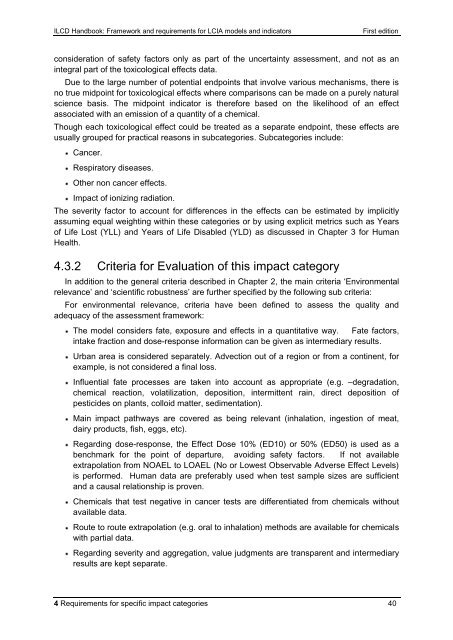ILCD Handbook: Framework and requirements for LCIA models and ...
ILCD Handbook: Framework and requirements for LCIA models and ...
ILCD Handbook: Framework and requirements for LCIA models and ...
Create successful ePaper yourself
Turn your PDF publications into a flip-book with our unique Google optimized e-Paper software.
<strong>ILCD</strong> <strong>H<strong>and</strong>book</strong>: <strong>Framework</strong> <strong>and</strong> <strong>requirements</strong> <strong>for</strong> <strong>LCIA</strong> <strong>models</strong> <strong>and</strong> indicators First edition<br />
consideration of safety factors only as part of the uncertainty assessment, <strong>and</strong> not as an<br />
integral part of the toxicological effects data.<br />
Due to the large number of potential endpoints that involve various mechanisms, there is<br />
no true midpoint <strong>for</strong> toxicological effects where comparisons can be made on a purely natural<br />
science basis. The midpoint indicator is there<strong>for</strong>e based on the likelihood of an effect<br />
associated with an emission of a quantity of a chemical.<br />
Though each toxicological effect could be treated as a separate endpoint, these effects are<br />
usually grouped <strong>for</strong> practical reasons in subcategories. Subcategories include:<br />
Cancer.<br />
Respiratory diseases.<br />
Other non cancer effects.<br />
Impact of ionizing radiation.<br />
The severity factor to account <strong>for</strong> differences in the effects can be estimated by implicitly<br />
assuming equal weighting within these categories or by using explicit metrics such as Years<br />
of Life Lost (YLL) <strong>and</strong> Years of Life Disabled (YLD) as discussed in Chapter 3 <strong>for</strong> Human<br />
Health.<br />
4.3.2 Criteria <strong>for</strong> Evaluation of this impact category<br />
In addition to the general criteria described in Chapter 2, the main criteria ‗Environmental<br />
relevance‘ <strong>and</strong> ‗scientific robustness‘ are further specified by the following sub criteria:<br />
For environmental relevance, criteria have been defined to assess the quality <strong>and</strong><br />
adequacy of the assessment framework:<br />
The model considers fate, exposure <strong>and</strong> effects in a quantitative way. Fate factors,<br />
intake fraction <strong>and</strong> dose-response in<strong>for</strong>mation can be given as intermediary results.<br />
Urban area is considered separately. Advection out of a region or from a continent, <strong>for</strong><br />
example, is not considered a final loss.<br />
Influential fate processes are taken into account as appropriate (e.g. –degradation,<br />
chemical reaction, volatilization, deposition, intermittent rain, direct deposition of<br />
pesticides on plants, colloid matter, sedimentation).<br />
Main impact pathways are covered as being relevant (inhalation, ingestion of meat,<br />
dairy products, fish, eggs, etc).<br />
Regarding dose-response, the Effect Dose 10% (ED10) or 50% (ED50) is used as a<br />
benchmark <strong>for</strong> the point of departure, avoiding safety factors. If not available<br />
extrapolation from NOAEL to LOAEL (No or Lowest Observable Adverse Effect Levels)<br />
is per<strong>for</strong>med. Human data are preferably used when test sample sizes are sufficient<br />
<strong>and</strong> a causal relationship is proven.<br />
Chemicals that test negative in cancer tests are differentiated from chemicals without<br />
available data.<br />
Route to route extrapolation (e.g. oral to inhalation) methods are available <strong>for</strong> chemicals<br />
with partial data.<br />
Regarding severity <strong>and</strong> aggregation, value judgments are transparent <strong>and</strong> intermediary<br />
results are kept separate.<br />
4 Requirements <strong>for</strong> specific impact categories 40



